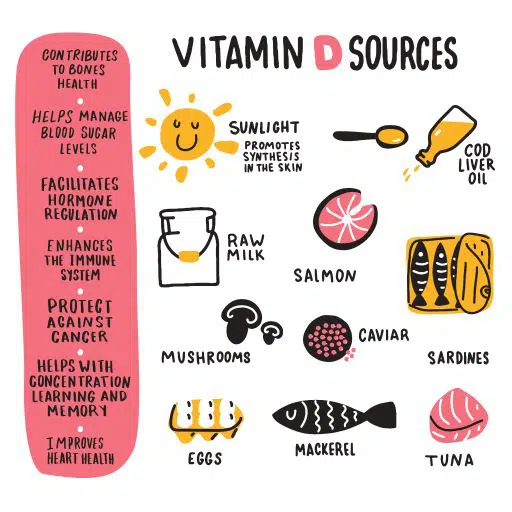A crucial nutrient that plays a vital role in maintaining overall health is Vitamin D3. For years, it was primarily known for regulating calcium and phosphorus levels in the blood, which are essential for healthy bones and teeth. Vitamin D, also known as cholecalciferol, has a complex physiology in the body as it interacts with over 300 of your body’s genes, and unlike many other vitamins, it functions more like a hormone. Receptors for vitamin D are found in all major organs of the body and other tissues throughout the body. Vitamin D has numerous benefits and a multifaceted importance as it is involved in supporting the immune system, aiding in cellular growth, and helping reduce inflammation.
Biological Functions of Vitamin D
Vitamin D is integral to several biological functions that are critical for maintaining health. One of its primary roles is in the regulation of calcium and phosphorus levels in the blood, which is essential for the formation and maintenance of strong bones and teeth. By promoting the absorption of these minerals from the digestive tract, Vitamin D3 ensures that they are available for critical bodily functions. It also decreases the loss of calcium from the body. Adequate levels of Vitamin D help prevent bone disorders such as osteoporosis and rickets by ensuring that bones remain dense and robust.
Vitamin D3 enhances the pathogen-fighting effects of white blood cells (WBCs) which are critical parts of the immune defense (monocytes and macrophages). It also decreases inflammation and promotes the production of antimicrobial chemicals, thus boosting the body’s ability to fend off infections.
Too much of a good thing can be bad, which is what autoimmune diseases are. Vitamin D helps prevent the immune system from running amok and may play a role in preventing autoimmune diseases. By promoting immune tolerance, it can reduce the risk of the immune system mistakenly attacking the body’s tissues, which is a hallmark of autoimmune disorders like multiple sclerosis and rheumatoid arthritis.
Vitamin D is involved in the regulation of cell growth and differentiation. It helps control the life cycle of cells, ensuring proper growth and timely apoptosis (cell death), which is vital for tissue regeneration and repair.
Vitamin D3’s Role in the Reduction of Inflammation
Vitamin D3 plays a significant role in the reduction of inflammation, a critical aspect of its broad health benefits. Chronic inflammation is a persistent, low-level inflammatory response that can contribute to the development and progression of numerous diseases, including cardiovascular disease, diabetes, cancer, and autoimmune disorders. Vitamin D3 helps mitigate inflammation through several mechanisms.
Vitamin D3 modulates both major types of immune responses, helping to maintain a balanced immune system. It encourages the production of substances that reduce inflammation, like interleukin-10 (IL-10), and decreases those that cause inflammation, such as interleukin-6 (IL-6) and tumor necrosis factor-alpha (TNF-α). This balance reduces collateral damage by decreasing overall inflammation and prevents your immune system from overreacting and damaging your tissues.
As previously stated, Vitamin D affects immune cells or white blood cells. One type of white blood cell it affects is regulatory T cells, which play a crucial role in maintaining immune tolerance and preventing autoimmune reactions. They help suppress inflammatory responses and ensure that the immune system does not attack the body’s tissues
Vitamin D3 can directly reduce inflammation by blocking key inflammatory pathways. One substance that it inhibits a protein that controls many genes involved in inflammation is called nuclear factor-kappa B (NF-κB). This is important because NF-κB is responsible for the production of inflammatory substances that increase inflammation.
Most people have heard of antioxidants. Oxidative stress happens when there are too many harmful molecules called reactive oxygen species (ROS) in the body, which leads to inflammation. Vitamin D3 helps the body fight these harmful molecules by increasing the production of antioxidant enzymes. These enzymes neutralize ROS, lowering oxidative stress and, as a result, reducing inflammation.
Recent studies show that Vitamin D3 can affect how your DNA is expressed by changing the way your genes are organized and modified. By influencing genes that are involved in inflammation, Vitamin D3 can have long-term effects on how inflammation is controlled in the body.

Sources of Vitamin D3
Fortunately, Vitamin D3 can be obtained from various sources, which are crucial for maintaining adequate levels of this essential nutrient.
Sunlight is the most significant natural source of Vitamin D3. When ultraviolet B (UVB) rays from the sun shine on exposed skin, Vitamin D3 is synthesized from available sources. In Toledo, our exposure to UV-B rays is limited by local weather and seasons to only a few months of the year. The glow of a computer monitor or phone is the only light that some people get now and when they do venture out, they immediately slather on sunscreen. Skin pigmentation can also modulate the amount of UV exposure that you get. While you should be conscious of preventing skin cancer, exposing the face, arms, and legs to sunlight for about 10-30 minutes several times a week can help maintain adequate Vitamin D3 levels.
Certain foods naturally contain Vitamin D3, though these sources are relatively limited compared to sunlight exposure. The richest dietary sources of Vitamin D3 include fatty fish (wild-caught salmon, sardines, and mackerel), egg yolks, liver and cod liver oil. Vitamin D3 can be added to commonly consumed foods, ensuring broader access to this essential nutrient. Foods commonly fortified with Vitamin D3 include milk and dairy products (cheese and yogurt) breakfast cereals and orange juice.

Vitamin D3 Supplements
Vitamin D3 supplements are an effective way to ensure adequate intake of this vital nutrient, especially for individuals who may have limited exposure to sunlight or dietary sources of Vitamin D3. These supplements come in various forms, allowing flexibility and convenience in meeting daily nutritional needs.
Capsules are a popular choice due to their ease of swallowing and precise dosage. They often contain oil-based solutions, which can enhance the absorption of Vitamin D3 since it is a fat-soluble vitamin. Drops offer flexibility in dosing and are particularly useful for children, elderly individuals, or those who have difficulty swallowing pills. Liquid forms can be easily added to food or beverages.
The appropriate dosage of Vitamin D3 can fluctuate based on age, health status, geographic location, and specific health needs. It is important to follow recommended guidelines and consult with a healthcare provider to determine the optimal dosage. Your dosage of Vitamin D3 should be individualized and specific to your needs.
Diseases of Vitamin D Deficiency
Vitamin D deficiency and insufficiency have been linked to a range of diseases and health conditions. These associations highlight the importance of maintaining optimal vitamin D levels for overall health and disease prevention. Here are some of the key diseases and conditions associated with less-than-optimal vitamin D levels:
- Bone and Muscle Disorders (Osteoporosis, Osteomalacia, Rickets, Myopathy)
- Cardiovascular Diseases (hypertension & heart disease)
- Autoimmune Diseases (Multiple Sclerosis (MS), Rheumatoid Arthritis & Type 1 Diabetes
- Infectious Diseases (Respiratory Infections like influenza and pneumonia)
- Inflammatory Bowel Disease (Crohn’s disease and ulcerative colitis)
- Asthma
- Cancer
- Depression and Anxiety
- Cognitive Decline and Dementia including Alzheimer’s disease
- Type 2 Diabetes
- Obesity

Benefits of Having Optimal Levels of Vitamin D
Maintaining optimal levels of vitamin D is crucial for overall health and well-being. Vitamin D, particularly in its D3 form, plays a vital role in numerous physiological processes and offers a range of health benefits when maintained at adequate levels, beyond just avoiding diseases caused by its deficiency.
One example would be muscle function and strength. Optimal levels help prevent muscle weakness and reduce the risk of falls and fractures, particularly in older adults. Adequate vitamin D levels support overall physical performance and endurance, contributing to better mobility and quality of life. Inadequate Vitamin D levels tendency to lead to muscle pain in a great number of my patients.
Blood Levels for Vitamin D Testing
Vitamin D testing typically measures the concentration of 25-hydroxy vitamin D3 or 25-OH Vitamin D3 in the blood, which is the most accurate marker of overall Vitamin D status. Understanding the different ranges of 25-OH Vitamin D levels is crucial for diagnosing deficiency, insufficiency, and ensuring adequate or optimal Vitamin D levels.
Vitamin D deficiency is defined as having 25-OH Vitamin D3 levels that are too low to maintain healthy bone metabolism and overall health. Insufficiency refers to levels of 25-OH Vitamin D3 that are higher than those seen in deficiency but are still not adequate for optimal health. Normal levels of 25-OH Vitamin D3 are those that are generally sufficient for maintaining bone health and overall physiological functions. Optimal levels of Vitamin D are those that are considered ideal for not only maintaining bone health but also for providing additional health benefits beyond the prevention of deficiency diseases.
- Deficiency: Levels below 20 ng/mL (50 nmol/L)
- Insufficiency: Levels between 20-30 ng/mL (50-75 nmol/L)
- Normal: Levels between 30-50 ng/mL (75-125 nmol/L)
- Optimal: Levels between 50-80 ng/mL (100-150 nmol/L)
Understanding “Deficient” and “Normal” levels is fairly easy but being “insufficient” is where most people are, and “optimal” is where everyone should be. Insufficient levels of Vitamin D may not fully support bone and muscle health and could potentially increase the risk of chronic diseases such as cardiovascular disease, certain cancers, and autoimmune disorders. People with insufficient levels might also experience more frequent infections and inflammation. Optimal Vitamin D levels are associated with a reduced risk of chronic diseases, including heart disease, certain cancers, and autoimmune conditions. They may also support better mental health, lower the incidence of infections, and improve inflammatory responses.
Depending on test results, healthcare providers may recommend lifestyle changes, dietary adjustments, or Vitamin D supplements to achieve and maintain optimal levels. Safe sun exposure practices, consuming Vitamin D-rich foods, and using supplements as needed can help maintain adequate Vitamin D levels. It’s important to recognize that optimal Vitamin D levels can vary based on individual health needs, geographic location, and underlying health conditions.
Regular testing of 25-OH Vitamin D3 levels can help maintain optimal Vitamin D status, especially for individuals at risk of deficiency or insufficiency, such as those with limited sun exposure, older adults, people with darker skin, and those with certain medical conditions. In the beginning, one should be tested after several weeks of supplementing if trying to raise levels to Optimal, then around once every six months until you have been stable. Twice a year is a good idea here in the Toledo area since we go several months in the year from mid-fall to mid-spring without spending much time in the sun.
General Dosage Recommendations
The amount of Vitamin D3 that a person should take is based on individual needs and cannot be accurately given as a blanket dosage. For years, 400 IU was what everyone was told to take per day, but the recommended daily allowance (RDA) changed in 2011 to 600-800 IU per day for adults. Many experts consider this to still be too low as it is essentially just enough to prevent severe bone diseases like osteomalacia and rickets, and not enough to harness the power of Vitamin D. So for this, I will tell you that the number is likely higher but that I cannot tell you what you need unless I am helping you as a patient.
Risks of Not Having a Guide
As stated, it is important to have a guide during this journey as there are risks of taking too much Vitamin D3. Personalized medical advice should guide supplementation and lifestyle changes.
Over-supplementation of vitamin D can lead to elevated calcium levels in the blood, known as hypercalcemia. Symptoms may include nausea, vomiting, weakness, confusion, and kidney stones. Prolonged excessive intake of vitamin D can also result in the deposition of calcium in soft tissues such as the kidneys, heart, and blood vessels, leading to organ damage and impaired function.
Healthcare providers, such as sports chiropractors with extra education in nutrition, may recommend baseline testing of serum 25-hydroxyvitamin D levels (25-OH Vitamin D3) to determine initial status and guide supplementation decisions. Based on individual needs and test results, healthcare providers can develop personalized dosage plans to achieve and maintain optimal vitamin D levels safely. Regular monitoring of serum vitamin D levels is essential to ensure the efficacy and safety of supplementation. Dosage adjustments may be necessary to maintain optimal levels and prevent toxicity.
While sunlight is a natural source of vitamin D, we all know that excessive sun exposure carries risks, including skin damage and increased risk of skin cancer. Sun safety practices, such as wearing sunscreen and protective clothing, should be followed to balance vitamin D synthesis with skin protection. In addition to supplementation, dietary sources of vitamin D, such as fatty fish, fortified foods, and supplements, can contribute to overall intake. A balanced diet rich in vitamin D-containing foods can help support optimal levels. Pregnant and lactating individuals may have increased vitamin D requirements to support maternal and fetal health.
Conclusion
Vitamin D3 is essential for overall health, functioning more like a hormone than a vitamin. It plays a crucial role in regulating calcium and phosphorus levels, which are vital for healthy bones and teeth. Beyond this, Vitamin D3 supports the immune system, helps with cell growth, and reduces inflammation. It also boosts antioxidant defenses, neutralizes harmful molecules, and affects gene expression to control inflammation. Adequate Vitamin D3 levels can prevent diseases like osteoporosis, cardiovascular issues, autoimmune disorders, and chronic inflammation. You can get Vitamin D3 from sunlight, certain foods like fatty fish and fortified products, or supplements. However, it’s important to balance intake to avoid over-supplementation, which can lead to health problems. Consulting with a healthcare provider ensures you maintain optimal Vitamin D3 levels for the best health outcomes.
